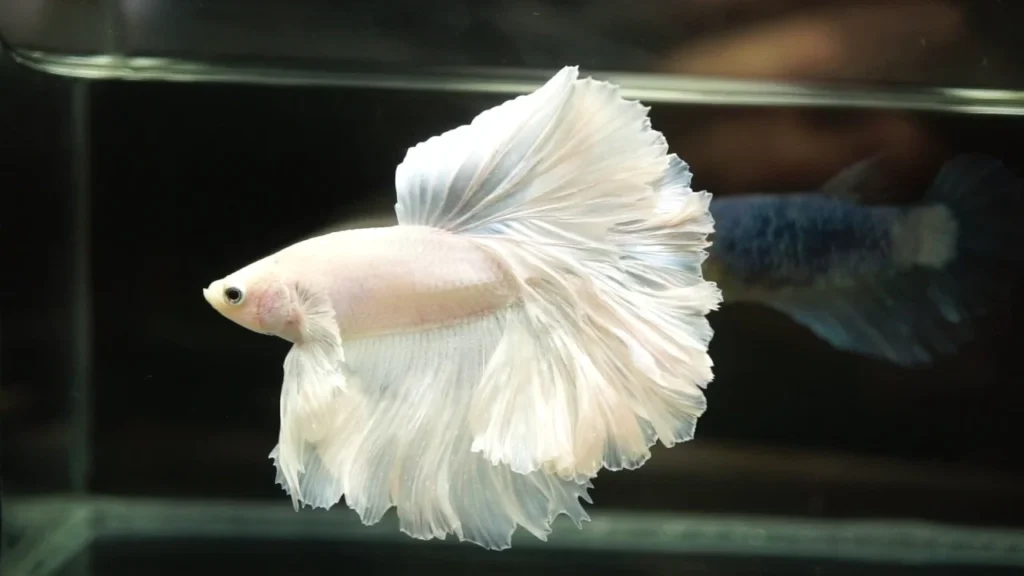Are you looking for a stunning and unique fish to add to your aquarium? Look no further than the platinum male betta fish! With its shimmering scales and vibrant colors, this fish will surely be the highlight of your aquatic collection. In this article, we’ll delve into the world of the platinum male betta fish, exploring its unique characteristics, care requirements, and everything else you need to know to keep your fish happy and healthy. Welcome to The Ultimate Guide to Platinum Male Betta Fish Care!
What is a Platinum Male Betta Fish?
A platinum male betta fish is a type of betta fish that has a striking white or silver coloration. The platinum coloration results from a genetic mutation that causes a lack of pigmentation in the fish’s scales, giving the fish a shimmering appearance that aquarium hobbyists highly prize. In addition to their unique coloration, they are known for their long, flowing fins and striking personalities. They are popular among beginner and experienced aquarists due to their ease of care and stunning beauty.
Characteristics of Platinum Male Betta Fish
The platinum male betta fish is a variant of the popular Siamese fighting fish, known for their aggressive nature and beautiful color patterns. However, they are peaceful creatures that can coexist with other fish in a community tank. Here are some of the key characteristics that make this fish so unique:
Color Variations
The platinum male betta fish is known for its shimmering silver scales that give it a platinum-like appearance. However, these fish come in various color variations, including white, cream, and light blue. Some fish also have iridescent scales that change color depending on the lighting conditions, adding to their mesmerizing beauty.
Finnage
This betta fish has long, flowing fins that make it a stunning sight. Its tail fin can be either spade-shaped or round, and its dorsal fin is long and elegant. These fins require special care to prevent damage and keep them healthy. Regular monitoring and maintenance of water quality are crucial to prevent fin rot and other common ailments.
Size and Lifespan
This type of betta fish typically grows to be around 2.5 inches long, making it a relatively small fish. However, it has a long lifespan, with some fish living up to 5 years in optimal conditions. Providing a stable environment and a balanced diet can significantly contribute to their longevity.
Caring for Platinum Male Betta Fish
Now that you know more about the platinum male betta fish, it’s time to explore how to care for this unique creature. Here are some key factors to consider when setting up your aquarium:
Tank Size and Environment
The platinum male betta fish requires a minimum tank size of 5 gallons, but larger tanks are preferable as they provide more space for swimming and reduce the risk of water quality issues. The water should be kept at a temperature between 76-82°F, with a pH of 6.0-7.5. Using a filter to maintain water quality and ensure adequate oxygen levels is essential. Additionally, adding plants and hiding spots can help create a more natural and comfortable environment for your betta.
Diet
This betta fish is an omnivore that eats both plants and animals. Its diet should consist of high-quality betta pellets supplemented with live or frozen foods such as bloodworms or brine shrimp. Providing a varied diet ensures that your betta receives all the necessary nutrients for optimal health. It’s important to feed them in small amounts 2-3 times daily to prevent overfeeding and maintain water quality.
Tank Mates
The platinum male betta is a peaceful creature that can coexist with other fish in a community tank. However, choosing tank mates carefully is vital to avoid aggression or territorial behavior. Good tank mates include other peaceful fish such as Neon tetras, Guppies, and Corydoras catfish. Avoid housing them with fin-nipping species or other male bettas to prevent conflicts.
Maintenance
Regular maintenance tasks such as water changes, filter cleaning, and tank cleaning are essential to keep your platinum male betta fish healthy and happy. Aim for a weekly water change of 25-30% to maintain water quality. Additionally, you should monitor the fish for any signs of illness or stress and take appropriate action if necessary. Keeping a close eye on your betta’s behavior and appearance can help you catch any issues early.
Common Health Issues and How to Address Them
Fin Rot
Fin rot is a common issue in betta fish, often caused by poor water quality or bacterial infections. It presents as fraying or disintegration of the fins. To treat fin rot, improve water quality through regular water changes and consider using aquarium salt or a specialized medication to help the fins heal.
Ich (White Spot Disease)
Ich is a parasitic infection that causes white spots on the fish’s body and fins. It can be treated by raising the water temperature slightly and using a commercial ich treatment. Quarantining affected fish and thoroughly cleaning the tank can prevent the spread of this parasite.
Swim Bladder Disorder
This disorder affects the fish’s ability to swim properly and is often caused by overfeeding or constipation. To treat swim bladder disorder, fast your fish for a day or two, then feed them a small amount of cooked, deshelled pea to help clear their digestive system.
Conclusion
The platinum male betta fish is a unique and beautiful addition to any aquarium. With proper care and attention, this shimmering aquatic creature can live a long and healthy life, bringing joy and wonder to its owners. By understanding the characteristics and needs of the platinum male betta fish, you can create the perfect environment for your fish to thrive and flourish.
The Ultimate Guide to Platinum Male Betta Fish Care emphasizes the importance of selecting the right tank mates, providing a balanced diet, and maintaining optimal water quality. Every aspect of their care contributes to their well-being. So why not add a little sparkle to your aquarium with a platinum male betta fish today? By following the guidelines in this comprehensive guide, you’ll be well-equipped to provide the best care for your platinum male betta fish, ensuring it remains a vibrant and healthy member of your aquatic family for years to come.
Happy fishkeeping! Remember, The Ultimate Guide to Platinum Male Betta Fish Care is here to help you every step of the way. Whether you’re a novice or an experienced aquarist, understanding the needs of your platinum male betta fish will lead to a thriving and beautiful aquarium. So, dive in and make the most of your fishkeeping experience with this stunning species.
FAQs
How do I tell if my platinum male betta fish is male or female?
Male platinum betta fish have longer, more flowing fins than females, and they are generally larger. Males also display more vibrant colors and may have a longer, pointed anal fin. Females have shorter fins and are usually less colorful.
Can I keep multiple platinum male bettas together?
Keeping multiple male betta fish in the same tank is not recommended, as they are territorial and may become aggressive toward each other. However, female betta fish can coexist peacefully in groups of 3-5 if the tank is large enough and there are plenty of hiding places and plants to create separate territories.
How often should I feed my betta fish?
Betta fish should be fed 2-3 times daily with only a few pellets or flakes. Overfeeding can lead to health problems and a buildup of waste in the tank. Observing your fish’s behavior during feeding can help you adjust the amount and frequency to meet their needs.
What should I do if my fish appears sick or stressed?
Signs of illness or stress in betta fish include lethargy, loss of appetite, abnormal swimming behavior, and discoloration. If you notice any of these symptoms, taking action immediately is crucial. Consult a veterinarian specializing in fish care or a knowledgeable aquarium hobbyist for advice on treating your fish. Isolating the sick fish in a quarantine tank can prevent the spread of illness to other tank mates.



